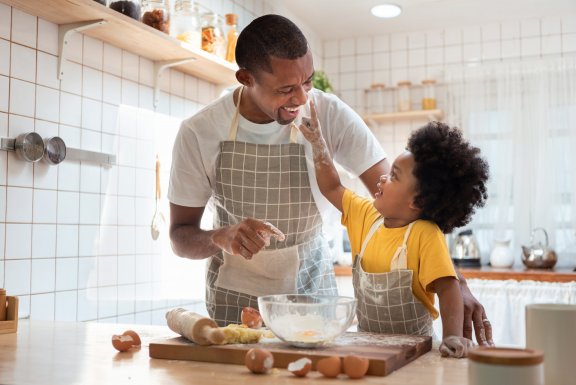National Bake for Family Fun Month

National Bake for Family Fun Month
Warm up the home and bring the family together in February during Bake for Family Fun Month! Everyone has an opportunity to get in the fun when you divide up the responsibilities and break down the steps. Baking is an inexpensive family activity that provides opportunities for families to share baking traditions, recipes and family heritage that can be handed down through each generation.
Depending on the size and age of your family, choose kid-friendly recipes. Pick a day of the week that’s flexible and let everyone take turns with the dirty jobs.
While having fun with the family, children will practice many skills. Older children will polish up their reading abilities. Following instructions becomes a practiced skill, and everyone will improve their chemistry and mathematics. They will have so much fun; they won’t even realize they were learning!
After all the baking and cleaning up, settle down to savor the results. Enjoy all the family closeness and delicious rewards.
How to Celebrate
Spend time with the family baking this month. Whether you bake with your children or invite grandparents or siblings over for baking sessions, don’t hesitate to make memories with each other!
Baking Tips to Share
- Do some prep work. Prep by reading and trying the recipe first. Add 20 to 30 minutes to explain, show and guide beginners and 15 minutes for intermediates or experienced bakers. Divide it into two sessions if needed, or pre-measure or prepare some steps beforehand.
- Keep it clean. Remember to wash hands and countertops before starting and cleaning up after you’re done. Provide separate towels for hands and dishes and frequently wash pot holders. Aprons or large T-shirts are great for keeping clothes clean during the baking process.
- Take it one step at a time. Read the recipe, gather ingredients, and make sure nothing was left out. When short on time, or working with beginning or young bakers, prepare some steps ahead or do some steps one day and complete the mixing or baking the next.
- Use the right tools. Pour liquid in a clear liquid measuring cup placed on the countertop. Read amount at eye level. Use standard dry measures for dry ingredients. Use measuring spoons for small amounts less than ¼ cup.
- Do a safe kitchen checklist. Turn handles of pans toward the center of the stove so sleeves or people passing by won’t catch on them and spill. Keep cupboard doors and drawers closed unless in use. Use only dry hot pads or oven mitts because heat goes through damp mitts. When stirring or checking for doneness, tilt the lid away from you so steam is released away from your face.
- Oven ins and outs. Before preheating, make sure the oven racks are in the right place for the pans and recipe. Preheat the oven as the recipe directs. Place pans in the oven so they do not touch each other or the oven sides. Do not place pans on racks directly below or above another pan. Keep clean, dry oven mitts or pads close by.
- Baking can be a learning experience. Children and adults learn a lot together in the kitchen. The results of cooking or baking together contributes to stronger relationships at home and in groups and children learn time management, team skills, following directions, and problem solving.

